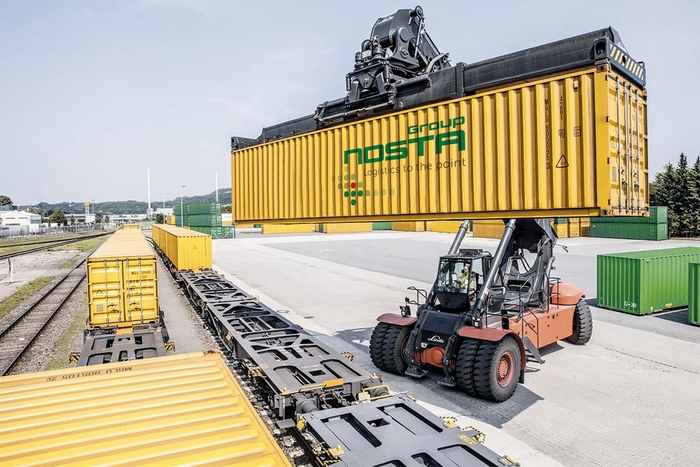In times of growing environmental awareness and increasing demands for sustainable transport solutions, combined transport (CT) is becoming more and more important. This innovative approach usually combines rail and road transport to increase efficiency while minimizing the environmental impact.
Together with Maximilian Eggert, head of our NOSTA CT terminal in Osnabrück, we take a closer look at the environmental benefits of combined transport and how it is helping to make the logistics industry greener. It is also worth taking a look at the efficiency benefits that this combination of transport modes can offer.
How does CT work in everyday business?
In everyday logistics, combined transport terminals are usually supplied with load units such as special trailers or containers by road transport. These units are placed on the rail wagons using a gantry crane or reach stacker. From there, the train travels to the receiving terminal, where the goods are then sent by road transport to the end customer. These solutions are often implemented for larger quantities of goods and over longer distances.
But what are the advantages of combined transport?
1. Combined Transport reduces emissions
In combined transport, several modes of transport are used to increase the flexibility and efficiency of the transport system. "Compared to conventional road transport, the use of our block trains significantly reduce carbon emissions per tonne. This is mainly due to the use of green electricity on electrified routes," explains Maximilian Eggert.
2. Combined Transport saves resources
For Maximilian Eggert, the conservation of resources in combined transport results from two factors: "On the one hand, we save fuel by reducing the number of road kilometers per ton. In addition, the number of professional drivers decreases. We need to actively create alternatives for this resource." In addition, there are significant benefits from lower emissions and an overall reduction in noise exposure.
3. Combined Transport moves large quantities
Freight trains at NOSTA Group can reach lengths of more than 600 meters. This means that one train can replace around 50 trucks, with each truck weighing a total of 40 tons. And every metre of train is used as efficiently as possible: "Depending on the goods being transported, our customers can load four tons more per load unit than with road transport alone. This allows us to make more efficient use of space," Eggert is certain. As a result, one train can move several hundred tons of goods with significantly less manpower.
4. Combined Transport creates stability
"Our customers include companies that have high demands for maintaining their production processes," explains Eggert. To achieve this goal, NOSTA Group uses long-term standard routes for its trains, which are defined for the entire duration of a timetable. "This allows us to be a stable part of the supply chain and also ensure supply on Sundays and public holidays," says Eggert.
Advantages of combined transport: conclusion
Combined transport provides a forward-looking solution to the challenges of modern logistics. By reducing emissions, using resources efficiently, transporting large volumes and being highly reliable, it helps to minimize the environmental impact. Investments in this sustainable transport alternative are therefore not only ecologically sensible, but can also lead to long-term economic benefits through adapted logistics processes.
Our Rail transportation


